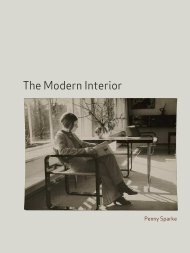Landscape Architecture: Landscape Architecture: - School of ...
Landscape Architecture: Landscape Architecture: - School of ...
Landscape Architecture: Landscape Architecture: - School of ...
- No tags were found...
You also want an ePaper? Increase the reach of your titles
YUMPU automatically turns print PDFs into web optimized ePapers that Google loves.
The Oslo Patch investigates a new way in which a large tract <strong>of</strong><br />
railway yards and busy railway lines can be inhabited. The location<br />
is close to downtown, but rather barren. Behind it lie some inner<br />
areas <strong>of</strong> mixed-use; the other side is almost at the edge <strong>of</strong> the fjord.<br />
A key interpretation is the avoidance <strong>of</strong> the boring formula <strong>of</strong><br />
draping the whole thing with a deck. Rather, there is a lacework <strong>of</strong><br />
waving strips <strong>of</strong> housing, allowing a wide variety <strong>of</strong> drapes,<br />
parasites and add-ons. Interlaced with these are a series <strong>of</strong><br />
vegetated and partially vegetated strips. On other axes are other<br />
strips <strong>of</strong> walkway. Underneath all <strong>of</strong> this – yet largely exposed – are<br />
the rail tracks themselves.<br />
The whole is thus a complex series <strong>of</strong> layered strips. A canal is<br />
brought in under cover into an ‘arcade’ condition. Above are special<br />
high-intensity student dwellings. A small sports and music stadium<br />
is located within the system. Much <strong>of</strong> the vegetation works itself up<br />
the sides <strong>of</strong> the housing buildings.<br />
The drawn project parallels a long section through the site and a<br />
‘collage-cartoon’ strip that identifies a series <strong>of</strong> inspirations from,<br />
and references to, Oslo – inflatables, flags, sports, snow, bridges –<br />
based on my experience <strong>of</strong> the city since 1968.<br />
Peter Cook, Mound, 1964<br />
A multi-use centre, inward-looking and covered with grass banks.<br />
cities could be absorbed within the natural environment.<br />
<strong>Landscape</strong> was here represented as a growing, enfolding<br />
aspect <strong>of</strong> urban expansion, an absorbent city conurbation,<br />
rather than something appropriated by the city.<br />
In 2004 Sponge City re-emerged, at the Design Museum in<br />
London, as the climax to a major Archigram exhibition. Here<br />
Cook pointed clearly to an environment <strong>of</strong> a totally built but<br />
growing landscape, forecasting, this time in the 21st century,<br />
the ways in which cities, or fragments <strong>of</strong> cities, will in future<br />
be absorbed into the proactive, recombinant landscape. As he<br />
wrote recently:<br />
‘The new architecture celebrates the fold-over <strong>of</strong><br />
contrived surface with grasped surface. The new<br />
sensibility is toward terrain rather than patches or<br />
pockets. There is even a search for peace without escape<br />
– difficult for one to imagine amongst the chatter <strong>of</strong> the<br />
old city. … For me it becomes even more intriguing if we<br />
pull the vegetal towards the artificial and the fertile<br />
towards the urban but in the end … to find the magic <strong>of</strong><br />
a place discovered, now that’s architecture.’ 1<br />
Cook’s prognosis takes society along an irreversible course:<br />
firstly, focusing on the ways people relate landscape and<br />
architecture; secondly, developing these strategies in terms <strong>of</strong><br />
‘making place’; and finally, considering the inherent<br />
connections between nature and urbanism. This new<br />
thinking is evident in his proposal for the Oslo waterfront<br />
(The Patch), in which all <strong>of</strong> these preoccupations dramatically<br />
come together, making place for the capital city in a way<br />
hitherto never anticipated – the built elements displaying a<br />
strong and organically tectonic structure with an enigmatic<br />
shrouding <strong>of</strong> membrane.<br />
Cook’s work in this area reveals that it is now time to plot<br />
the evolution <strong>of</strong> a relevant 21st-century preoccupation – the<br />
idea <strong>of</strong> conjoining landscape and architecture as a single,<br />
collusive environment. 4<br />
Note<br />
1. In Catherine Spellman (ed), Re-Envisioning <strong>Landscape</strong>/<strong>Architecture</strong>, Actar<br />
(Barcelona), 2003.<br />
Text © 2007 John Wiley & Sons Ltd. Images © Peter Cook<br />
15



